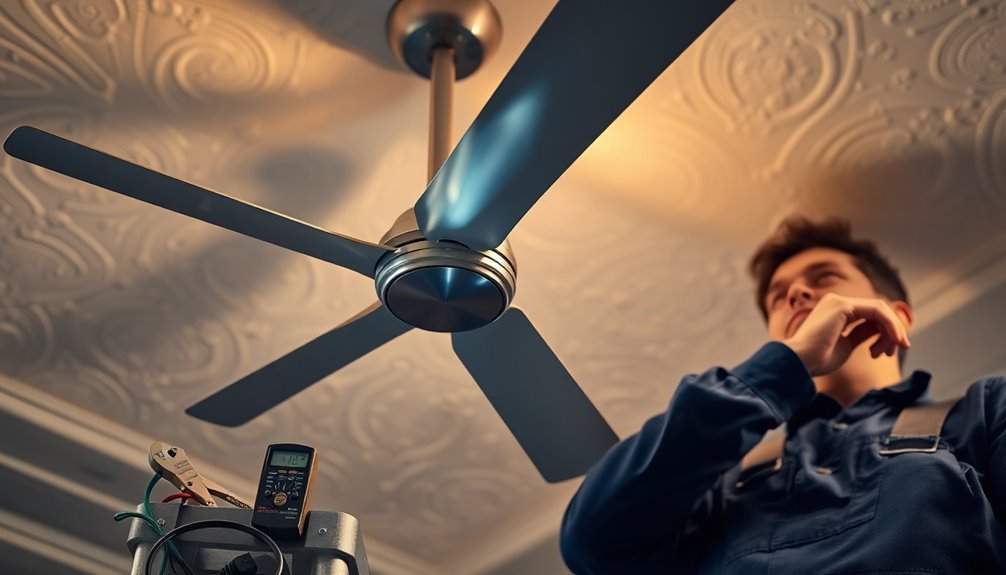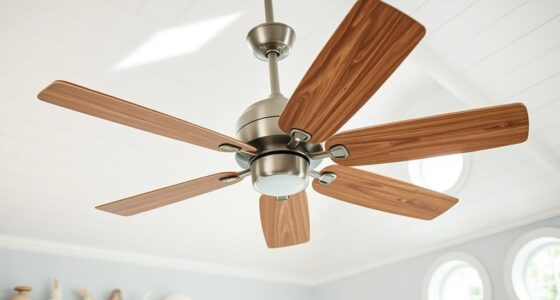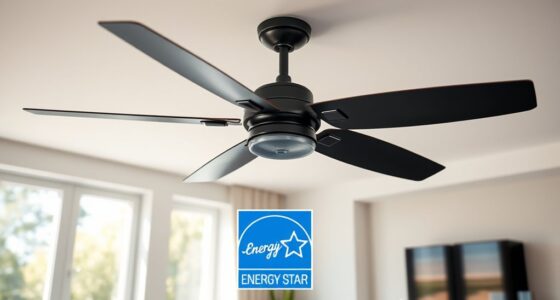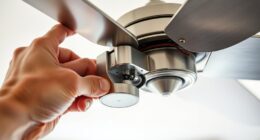Ceiling fans work by using a motor to spin blades, which creates airflow that cools you down. As the blades rotate, they generate a downward breeze that enhances evaporative cooling, helping moisture evaporate from your skin. You can adjust the fan's direction; counterclockwise in summer for cooling and clockwise in winter to circulate warm air. The distance of the fan from the ceiling and the height from the floor also affect airflow efficiency. To keep your fan running smoothly, you'll want to evaluate proper maintenance and care. Continue exploring to find out more about maximizing your ceiling fan's benefits.
Key Takeaways
- Ceiling fans use rotating blades to create airflow, enhancing cooling through evaporative cooling and reducing reliance on air conditioning.
- The motor powers the blades, converting electrical energy into mechanical energy to generate downward airflow for effective air circulation.
- Blades should be positioned 7-9 feet above the floor and 10-12 inches from the ceiling to optimize airflow and prevent overheating.
- The fan's rotation direction can be adjusted: counterclockwise for cooling in summer and clockwise for circulating warm air in winter.
- Proper maintenance, such as regular cleaning and inspection, ensures efficient operation and prolongs the fan's lifespan.
Principle of Ceiling Fan Operation

Ceiling fans operate on a simple yet effective principle that combines mechanical motion with fluid dynamics. When you turn on a ceiling fan, it utilizes a motor that powers blades to rotate in a circular motion. This rotation generates significant air movement, creating a downward airflow that enhances the cooling effect in your space.
By increasing the rate at which moisture evaporates from your skin, ceiling fans promote evaporative cooling, making you feel cooler even in warm conditions.
This operation is based on Bernoulli's law, which states that as air velocity increases, pressure decreases. As the blades spin, they create a low-pressure zone above them, drawing in air from below.
Depending on your needs, you can set the fan to rotate counterclockwise in summer for a revitalizing downdraft or clockwise in winter to circulate warm air effectively.
Key Components of Ceiling Fans

When it comes to ceiling fans, the interaction between the motor and blades is essential for effective airflow.
You'll notice that the motor powers the blades, which are specifically designed to maximize air movement in your space.
Understanding these key components helps you appreciate how your ceiling fan keeps you comfortable.
Motor and Blades Interaction
How do the motor and blades of a ceiling fan work together to create a comfortable environment? The motor is the powerhouse of the fan, converting electrical energy into mechanical energy. It drives the rotation of the blades through a copper wire coil and rotor system.
As the motor spins, it connects to the blades via a central hub, ensuring stability and support during their rotation.
The blades themselves, often made from wood, plastic, or metal, are designed to optimize airflow and maximize cooling. Their size and shape play a significant role in how effectively they move air throughout the room.
When the motor turns the blades, they create a downward airflow, which enhances the cooling effect, making your space feel more comfortable.
You can also customize this airflow using the fan's control system, which regulates the fan's speed and direction. This means you can adjust the cooling effect according to your seasonal needs, creating the perfect environment in your home.
Ultimately, the interaction between the motor and blades is essential for delivering efficient airflow and consistent cooling.
Airflow Dynamics Explained
The interaction between the motor and blades sets the stage for understanding airflow dynamics in ceiling fans. When you turn on a ceiling fan, the motor converts electrical energy into mechanical energy, causing the blades to spin. This movement generates air that moves throughout your space, creating a noticeable airflow in a room.
The design of the blades—specifically their pitch and size—plays a vital role in how effectively ceiling fans work. Larger blades can push more air, enhancing your comfort, but they also require more energy.
In summer, the fan creates a downward draft, which helps evaporate sweat, making you feel cooler. Conversely, in winter, reversing the blade direction creates an updraft, allowing the fan to circulate warm air trapped near the ceiling.
Key components like the central hub and control system support this functionality, allowing you to adjust speed and airflow direction for maximum comfort. Additionally, regular maintenance of ceiling fans, such as filter replacement, can enhance their efficiency and prolong their lifespan.
For the best performance, make sure your fan blades are positioned 7-9 feet above the floor, ensuring efficient air circulation throughout your space. With these dynamics, ceiling fans effectively enhance your living environment all year round.
Mechanism of Air Circulation

Ceiling fans create effective air circulation by utilizing spinning blades that generate a downward airflow. As the blades rotate, they pull air from the ground and push it downward, enhancing cooling by increasing evaporation from your skin. This airflow relies on fluid dynamics principles, specifically Bernoulli's law. The spinning blades create a low-pressure zone above them, drawing in air from the surrounding area, which contributes to overall air circulation.
You can adjust the direction of the blade rotation to match the season. In summer, a counterclockwise motion creates a cooling downdraft, while clockwise rotation promotes an updraft that redistributes warm air in winter. This mechanism not only cools you but also helps mix the various temperature layers in the room, ensuring a more uniform temperature distribution.
For peak performance, install your ceiling fan 7-9 feet above the floor. This height allows for effective air movement and prevents stagnation, ensuring that the circulating air reaches you comfortably.
Cooling Effect Explained

Experiencing a cooling effect is one of the key benefits of using a ceiling fan, thanks to the way it enhances evaporative cooling. When you turn on your ceiling fan, the blades rotate in a counterclockwise direction, pushing air downward to create a revitalizing breeze. This movement helps to cool your skin by increasing the evaporation rate of sweat, which is your body's natural cooling mechanism.
With a ceiling fan moving air effectively, you can enjoy a cool environment without relying solely on air conditioning. In fact, you can often raise your thermostat by up to 4°F while still feeling comfortable. This not only saves you money but also reduces energy consumption, making ceiling fans a more efficient choice.
Properly maintained fans guarantee even air distribution, preventing warm and cool air layers from stratifying in your space. By creating a consistent airflow, ceiling fans enhance comfort levels throughout the room while being energy-efficient.
Seasonal Functionality Adjustments

Adjusting your ceiling fan for seasonal functionality is essential for maximizing comfort and energy efficiency year-round.
In the summer, you should guarantee your ceiling fan rotates counterclockwise. This direction creates a downdraft, enhancing effective cooling by pushing air downwards and making your space feel cooler. You can even raise your thermostat setting by up to 4°F without sacrificing comfort, thanks to the cooling effect of the moving air.
When winter rolls around, it's time to switch on your ceiling fan and reverse its direction to clockwise. This adjustment promotes an updraft, circulating warm air that has risen to the ceiling back down into your living space.
During this season, keep the fan speed on low to gently mix the warm and cool air layers without creating a chilling draft.
Energy Efficiency Benefits

Using ceiling fans year-round can lead to significant energy savings, as they help with both cooling in the summer and heat distribution in the winter.
By enhancing air circulation, you can reduce your reliance on air conditioning, allowing you to raise your thermostat settings without sacrificing comfort.
This simple adjustment can lower your energy bills and make your home more efficient.
Year-round Energy Savings
Ceiling fans offer a simple yet effective way to save on energy costs throughout the year. By incorporating ceiling fans into your home, you can achieve significant energy savings while maintaining a comfortable environment.
Here's how they help:
- Summer Savings: You can raise your thermostat by about 4°F without sacrificing comfort, reducing reliance on air conditioning.
- Energy-Efficient Models: Choosing ENERGY STAR® labeled fans can cut electricity use by up to 40% compared to traditional fans, lowering your utility bills.
- Winter Assistance: In colder months, running your ceiling fan clockwise circulates warm air, minimizing furnace usage and enhancing energy savings.
- Complementary Use: Using ceiling fans alongside your heating and cooling systems reduces overall energy consumption, leading to long-term savings.
With ceiling fans, you not only enhance air circulation but also create a more comfortable atmosphere in your home.
Implementing these fans can lead to a noticeable reduction in your energy bills year-round, making them an excellent investment for your comfort and your wallet.
Enhanced Air Circulation
Enhanced air circulation is one of the most significant benefits of ceiling fans, making your home feel more comfortable while boosting energy efficiency. By circulating air effectively, ceiling fans can help you raise your thermostat settings by up to 4°F without sacrificing comfort. This simple adjustment can lead to substantial energy savings, especially during the summer months.
When you run your ceiling fan in a counterclockwise direction, it enhances airflow and increases the evaporation rate of sweat, providing a revitalizing cooling effect. This means you can cool a room more efficiently, reducing your reliance on air conditioning.
In fact, using ceiling fans alongside your air conditioning can decrease energy usage by up to 30%, as they help distribute cool air evenly throughout your space.
Additionally, opting for ENERGY STAR® certified ceiling fans guarantees you're choosing models that are up to 40% more efficient than conventional ones, further reducing your energy bills.
Installation Considerations

When installing a fan, it's essential to take into account the height and spacing to guarantee peak performance and safety. Proper placement guarantees that ceiling fans throughout your space can effectively circulate air from the ceiling, creating a comfortable environment.
Here are key installation considerations:
- Height: Install the fan blades 7-9 feet above the floor. This height promotes effective airflow while safeguarding safety.
- Clearance: Maintain at least 10-12 inches of space between the fan and the ceiling. This allows for proper circulation and prevents overheating of the motor.
- Wall Distance: Confirm there's at least 18 inches of space between the fan and any walls. This spacing is essential for ideal air distribution and reducing noise.
- Room Size: For rooms longer than 18 feet, consider installing multiple fans. This enhances airflow and overall comfort throughout the space.
Maintenance and Care Tips
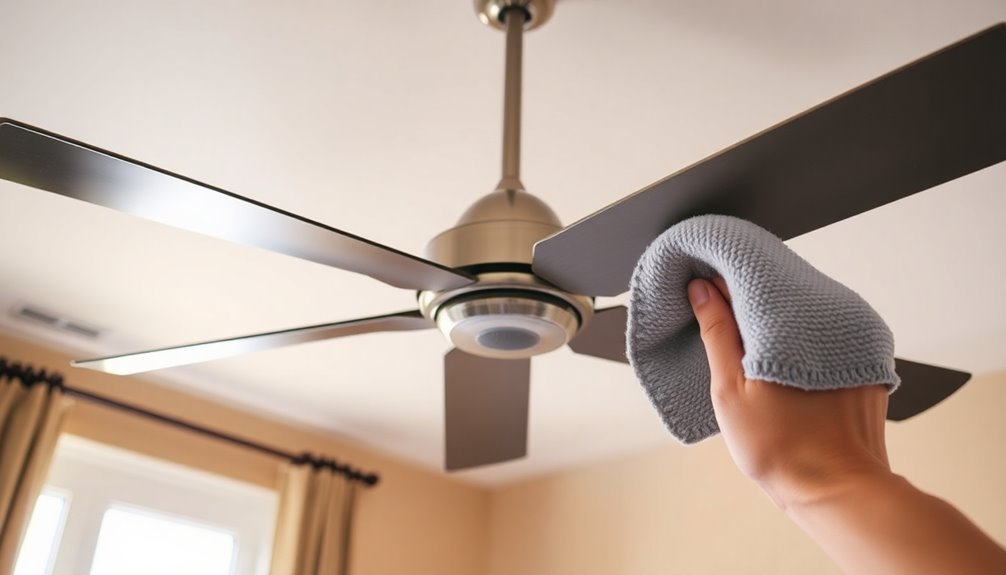
To keep your ceiling fan running smoothly, you should establish a regular cleaning schedule for the blades, dusting them every week or two.
Don't forget to lubricate the moving parts annually to guarantee everything operates without a hitch.
These simple steps can greatly enhance the fan's performance and lifespan.
Regular Cleaning Schedule
Keeping your ceiling fan clean is essential for excellent performance and efficiency. Regular cleaning prevents dust from accumulating on the blades, which can hinder airflow and reduce the fan's effectiveness.
Here's a simple maintenance schedule to keep your fan in top shape:
- Weekly Dusting: Use a dusting spray and a soft cloth to wipe down the blades. Always make sure the fan is turned off before you start cleaning to avoid accidents.
- Monthly Check: Inspect the fan for any loose screws or connections. Tightening these can prevent wobbling and other mechanical issues, enhancing your fan's reliability.
- Light Fixture Maintenance: Wash light fixtures attached to the fan with soapy water every few months. This helps maintain brightness and functionality, contributing to the overall performance of your ceiling fan.
- Deep Clean: Annually, conduct a thorough cleaning of the fan. This includes checking for any signs of wear on the blades and making certain everything is in working order.
Lubrication of Moving Parts
After maintaining a regular cleaning schedule, it's important to focus on another key aspect of ceiling fan maintenance: lubrication.
Regular lubrication of moving parts, like the motor and bearings, is essential for keeping your fan running smoothly. When you lubricate these components, you reduce friction and prevent wear over time, which can greatly extend the fan's lifespan.
Use a lightweight machine oil specifically designed for ceiling fans. Just apply a few drops to the motor and any exposed bearings as part of your annual maintenance routine.
Always make sure that the fan is turned off and disconnected from power before you start, as this prevents accidents and guarantees your safety.
Don't forget to check the manufacturer's guidelines for lubrication intervals and recommended products. This step is vital to avoid damaging your fan's motor and components.
Proper lubrication not only enhances efficiency and performance but also helps keep noise levels down during operation.
Troubleshooting Common Issues

Ceiling fans can sometimes run into issues that disrupt their performance, but many of these problems are relatively easy to troubleshoot.
Here are some common issues you might encounter and how to address them:
1. Wobbling: If your fan wobbles, check for loose screws and tighten them.
Verify the blades are properly balanced; a balancing kit can help by adding weight to specific blades, resulting in smoother operation.
2. Airflow Problems: Insufficient airflow may be caused by an unbalanced fan or inadequate motor power.
Adjust the blade pitch or verify the motor size matches your room's dimensions to improve airflow.
3. Noisy Operation: A humming or buzzing noise usually signals loose parts or motor issues.
Inspect the fan for any loose components that need tightening or replacement.
4. Lighting Issues: If your light bulbs flicker, it may stem from improper wiring or faulty fixtures.
Check the wiring connections and verify your bulbs are compatible with the fan.
Advanced Fan Technologies

Innovation in ceiling fan technology has transformed how we experience comfort and efficiency in our homes. Advanced fan technologies have made a significant impact, particularly with the introduction of energy-efficient DC motors.
These motors not only consume less energy but also operate more quietly than traditional AC motors, allowing you to enjoy a peaceful environment while saving on energy costs.
Smart ceiling fans take convenience to the next level by featuring Wi-Fi connectivity. You can control fan speed, direction, and lighting through smartphone apps or voice-activated devices, giving you complete customization at your fingertips.
This means you can adjust your fan settings without getting up from the couch!
Variable speed control technology enhances your experience further by allowing you to set the fan to different speeds with precision. Whether you prefer a gentle breeze or a strong gust, you can tailor the airflow to fit your needs and room conditions.
Additionally, many modern ceiling fans come with integrated sensors that detect room occupancy.
This smart feature optimizes energy use by adjusting fan operation based on real-time conditions, ensuring your comfort while keeping energy consumption to a minimum.
Frequently Asked Questions
How Do Ceiling Fans Cool a Room?
Ceiling fans cool a room by creating airflow that enhances the evaporation of sweat on your skin, making you feel cooler.
When you set the fan to spin counterclockwise, it pushes cool air downward, generating a revitalizing breeze. You can raise your thermostat by up to 4°F without losing comfort, saving energy.
In winter, reversing the fan helps distribute warm air evenly, keeping your space cozy throughout the year.
What Is the Working Principle of a Ceiling Fan?
The working principle of a ceiling fan revolves around its motor and blades. When you turn it on, the motor spins the blades in a circular motion, creating airflow.
This movement generates a downward draft, enhancing comfort by circulating air throughout the room. The design and angle of the blades are essential, allowing for efficient air movement.
You can also reverse the fan's direction to either cool or circulate warm air, depending on the season.
Should You Leave Ceiling Fans on All the Time?
You might think leaving ceiling fans on all the time is harmless, but it could be costing you.
Fans don't cool air; they just create airflow that makes you feel cooler.
When you leave them running in an empty room, you waste energy and increase your bills.
Instead, turn them off when you're not around.
You'll save money and still enjoy that invigorating breeze when you need it most.
Why Is My Ceiling Fan Not Cooling the Room?
If your ceiling fan isn't cooling the room, check a few things first.
Make sure it's set to spin counterclockwise for summer cooling.
Clean the blades to guarantee proper airflow, and verify it's installed at the right height and distance from the ceiling.
Look for any obstructions around the fan that might block airflow.
Finally, if it's wobbling or noisy, it might need balancing to work effectively.
Conclusion
To summarize, understanding how ceiling fans work can enhance your comfort and save you money. Did you know that using ceiling fans can allow you to raise your thermostat by 4°F without sacrificing comfort? This simple adjustment can lead to a 15% reduction in cooling costs, making your space more energy-efficient. By optimizing your fan's use and keeping it well-maintained, you'll enjoy a cooler environment while helping the planet and your wallet.

